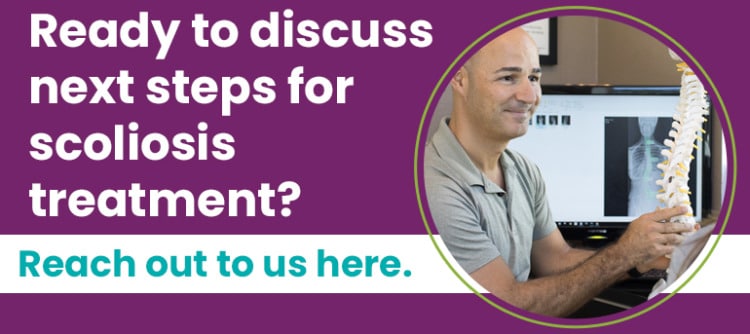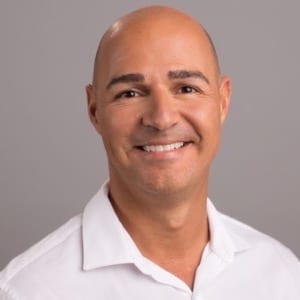Scoliosis Reduction Center Blog: Your Resource for Spinal Health

Welcome to the Scoliosis Reduction Center® blog, where we have curated a comprehensive list of topics to answer all your scoliosis questions. From the benefits of conservative treatment to parents in search of the best treatment option for a child, the answers are within reach.
Here at the Scoliosis Reduction Center®, the focus is on treating scoliosis proactively and conservatively with the goal of preserving as much of the spine's natural strength and function as possible. The Center also prioritizes education through spreading awareness.
While there are a number of topics covered in the Center's blog posts, an important message is the potential power of early detection and conservative treatment.
Table of Contents
Early Detection is Key
Scoliosis causes the spine to bend and twist, and an unnatural sideways curvature of the spine with rotation can have a number of effects.
Scoliosis treatment has to counteract the condition's progressive nature, which is to get more severe over time, and this means the size and twist of the curve will increase.
In most cases of scoliosis, we don't understand why they initially develop, but we do understand what makes it progress: growth.
So young patients who are still growing are more at risk of their scoliosis advancing rapidly, and as the most prevalent type of scoliosis is adolescent idiopathic scoliosis, this age group is the most at risk for rapid progression due to the growth spurts of puberty.
While patients of all ages can benefit from early detection, when it comes to childhood scoliosis, as progression is triggered by growth, there are additional benefits to starting treatment prior to the start of significant growth spurts.
However, there are a number of reasons that childhood scoliosis can be difficult to detect, particularly adolescent idiopathic scoliosis, so before getting to the specific benefits associated with early detection, let's start with why it can be a challenge.
Barriers to Early Detection of Childhood Scoliosis
Here at the Scoliosis Reduction Center®, our purpose is twofold: scoliosis treatment and education.
We want to treat scoliosis proactively, but we also want to educate the public on the importance of early detection, and the best way to do that is to spread awareness about the condition's early signs because they can be subtle.
Although childhood scoliosis patients have the most to gain from early detection and intervention, it's generally more difficult to diagnose than adult scoliosis.
Lack of Compressive Pain
While adult scoliosis can be painful due to compression, this is because scoliosis doesn't become a compressive condition until skeletal maturity has been reached, so for children who are still growing, pain isn't a common symptom.
Growing spines are constantly experiencing a lengthening motion, and this motion counteracts the compressive force of the unnatural spinal curve.
While no one wants to experience pain, it does serve a purpose: indicating that something is wrong inside the body that requires attention.
Subtle Postural Symptoms
Another barrier to early detection of childhood scoliosis is subtle symptoms at the mild level.
Scoliosis ranges in severity from mild cases to moderate scoliosis, severe, and very severe scoliosis.
In mild cases, symptoms can be subtle and difficult for an average person to notice, unless the average person is educated on the early signs to look for.
In many cases, the earliest signs of scoliosis are uneven shoulders and uneven hips.
As scoliosis develops and progresses, it can disrupt the body's overall symmetry through postural changes.
While uneven shoulders and hips are early indicators, parents should also watch for:
- The head appearing not centered over the torso
- An uneven eye line
- Uneven shoulder blades
- The development of a rib cage arch
- Arms and legs that hang at different lengths
- Ill-fitting clothing
Additional changes involving movement develop as the body becomes more asymmetrical: disruptions to balance, coordination, and gait.
Another challenge that's associated with diagnosing adolescent idiopathic scoliosis is transparency.
Adolescents and Transparency
While adolescent idiopathic scoliosis is the most common type of scoliosis, there are some extra challenges associated with its early detection, and it involves the age group affected.
Adolescent scoliosis is diagnosed between the ages of 10 and 18, and this age group is not exactly known for their transparency.
Many adolescents and teenagers are self-conscious about all the body changes they are going through, so for some that may notice some confusing postural changes occurring, changes are concealed, not shared, and the body can compensate for postural changes in a number of ways that can make it more difficult to detect.
In addition, teenagers aren't exactly known for good posture, so postural changes can seem like little more than the development of a classic adolescent-slouch.
When changes are occurring in a patient who wants to conceal them, baggy clothing can do a lot, and if they are not wanting to share changes with their parents, scoliosis can progress with growth until it becomes noticeable enough to overtly indicate the need for assessment.
The bottom line is most adolescents and teenagers don't want to look or walk differently from their peers, so many conceal these types of changes, making it even more difficult to diagnose cases early when there is the best chance of successful treatment.
Writing Scoliosis Hope and regularly publishing up-to-date blog posts on these types of challenges can help educate parents and caregivers on the early signs of scoliosis to watch for.
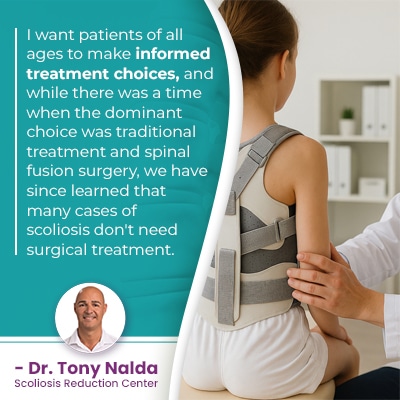 I want patients of all ages to make informed treatment choices, and while there was a time when the dominant choice was traditional treatment and spinal fusion surgery, we have since learned that many cases of scoliosis don't need surgical treatment.
I want patients of all ages to make informed treatment choices, and while there was a time when the dominant choice was traditional treatment and spinal fusion surgery, we have since learned that many cases of scoliosis don't need surgical treatment.
The Power of Conservative Treatment Options
A recurring topic readers will see in many of the Center's posts is the different scoliosis treatment approaches, and this is important because different treatment options can shape the spine's long-term health and function.
And as a progressive condition, patients also need to understand that treatment is about addressing an ongoing condition, but it can be highly treatable, particularly with early detection and intervention.
No treatment results can ever be guaranteed, but if early detection is followed by early intervention, there are fewer limits to what nonsurgical treatment can provide, and scoliosis surgery comes with a number of risks and potential long-term side effects.
Conservative treatment is proactive. There is no watching and waiting. As a progressive condition, virtually all cases are going to get worse at some point, so observing is wasting valuable treatment time, and progression only makes conditions more complex to treat, so there is no benefit to delaying treatment.
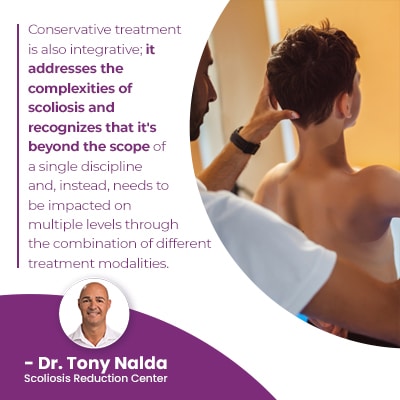 Conservative treatment is also integrative; it addresses the complexities of scoliosis and recognizes that it's beyond the scope of a single discipline and, instead, needs to be impacted on multiple levels through the combination of different treatment modalities.
Conservative treatment is also integrative; it addresses the complexities of scoliosis and recognizes that it's beyond the scope of a single discipline and, instead, needs to be impacted on multiple levels through the combination of different treatment modalities.
Condition-specific chiropractic care, physical therapy, scoliosis exercises, and rehabilitation work together to achieve structural changes and increase support and stability for the spine and body.
When these types of disciplines are customized and apportioned accordingly based on how the spine responds to treatment and/or growth, scoliosis treatment may help reduce the curve, manage pain, and restore the spine's alignment.
Conclusion
The Scoliosis Reduction Center® blog has the goal of education. I want patients to make informed treatment choices, and I want patients and parents to understand what early detection can offer when followed by a proactive treatment approach.
There are a number of direct links between early detection and treatment success, but only if the diagnosis is met with a proactive treatment plan.
Proactive treatment plans are the keystone of the Center's methodology; each plan is customized based on a number of patients and condition variables.
The more comprehensive a patient's initial assessment and diagnosis are, the more customized treatment plans can be for the most precise potential results.
There are no treatment guarantees, but one thing we do know is that scoliosis does not get easier the more it progresses, so why not start treatment early, when conditions are at their mildest and most likely to respond well.
In addition to being aware of the early physical symptoms to watch for, knowing the risk factors can also help direct a child towards regular screening; risk factors include gender, age, and a family history.
Adolescent females are more frequently diagnosed and are 10 times more likely to develop more-severe scoliosis. Adolescents between the ages of 10 and 18 are the most at risk, and while having a family history is considered a risk factor, it doesn't mean the condition is genetic, but familial; having another family member diagnosed does indicate increased chances of another diagnosis in the family due to shared factors.
If you or someone you care about is showing early signs of scoliosis, don't hesitate to reach out for support; it can help guide a loved one towards early detection and successful treatment.
Dr. Tony Nalda
DOCTOR OF CHIROPRACTIC
After receiving an undergraduate degree in psychology and his Doctorate of Chiropractic from Life University, Dr. Nalda settled in Celebration, Florida and proceeded to build one of Central Florida’s most successful chiropractic clinics.
His experience with patients suffering from scoliosis, and the confusion and frustration they faced, led him to seek a specialty in scoliosis care. In 2006 he completed his Intensive Care Certification from CLEAR Institute, a leading scoliosis educational and certification center.
About Dr. Tony Nalda
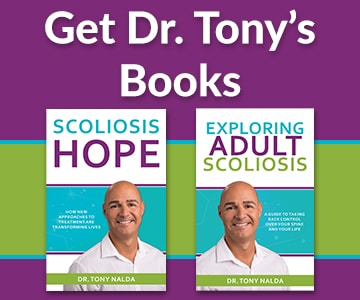 Ready to explore scoliosis treatment? Contact Us Now
Ready to explore scoliosis treatment? Contact Us Now